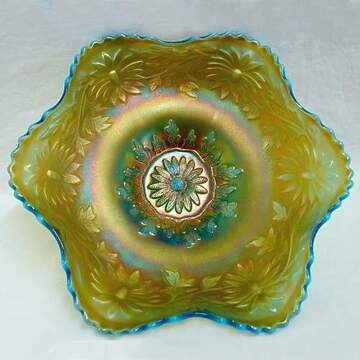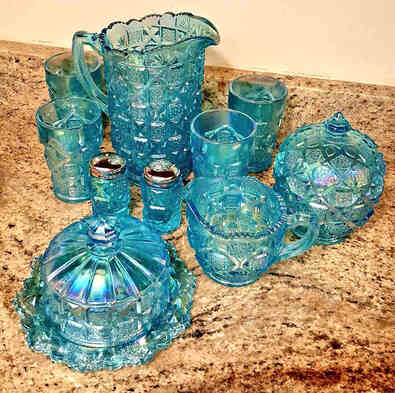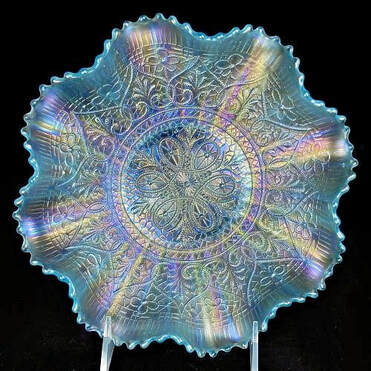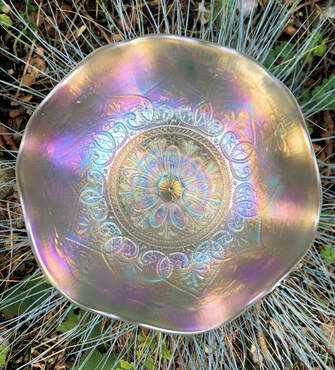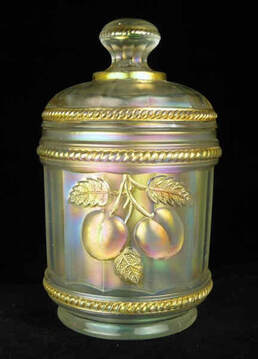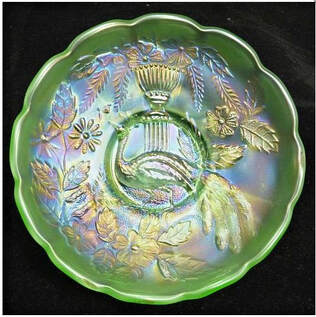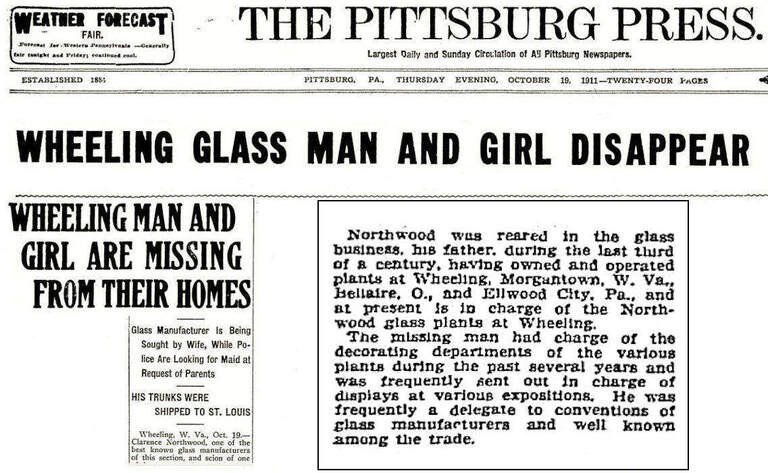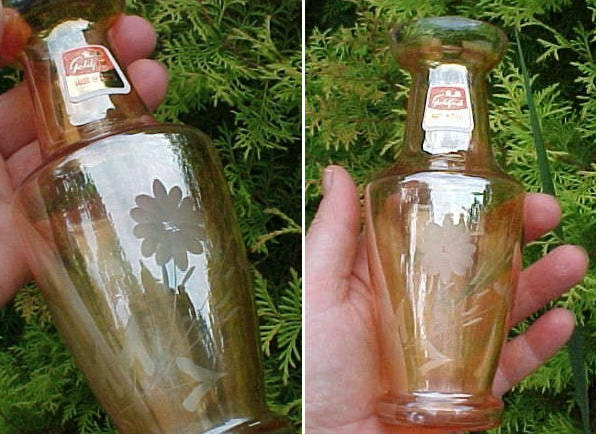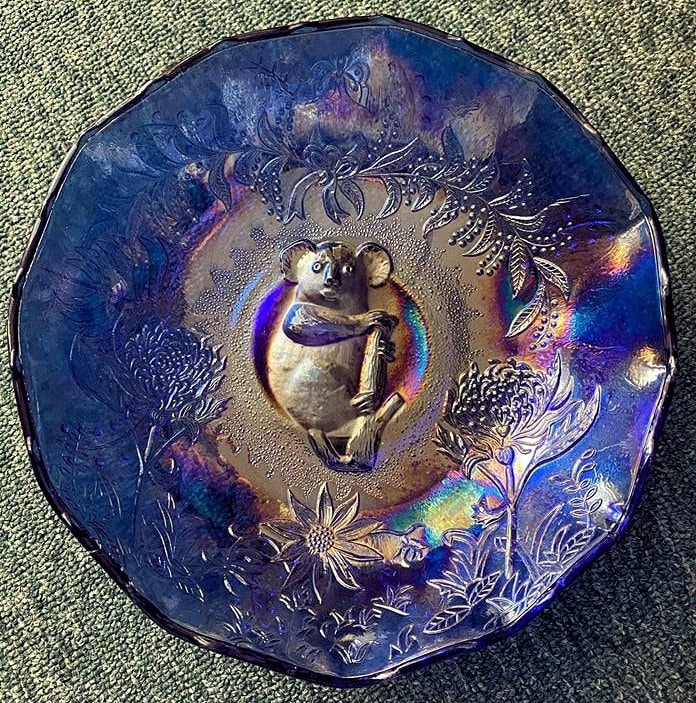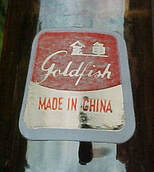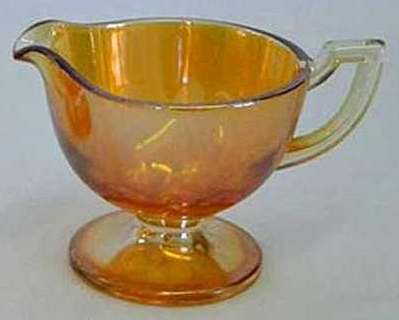NetworK ezine Issue 64. September 2020
Totally Devoted to Carnival Glass
Welcome to the September issue of Carnival Glass NetworK.
We begin by extending a very warm welcome to our many, new ezine subscribers – we hope you will enjoy receiving your free ezine, and you can find a link to all the Back Issues in the footer.
|
In this Issue
In this issue we’ll be taking a look at Northwood’s introduction of pastel Carnival colours in a very different way – but first, we have a major new feature on Westmoreland (and more on our website). Plus, we even get to talk about Koalas, Goldfish and Annie! Westmoreland's Carnival Glass
When you think of Classic Carnival, the name Westmoreland does not automatically spring to mind. They were not part of the so-called "big five" (Fenton, Imperial, Dugan, Northwood and Millersburg), and their output was what might be called unambitious, although they were quick to see the potential for Carnival Glass, advertising in Butler Brothers catalogue as early as 1908. It appears that there was a reluctance to "go for it" in the way that Fenton, Dugan and Northwood did. Having said that, we must recognise that Westmoreland made some really beautiful Classic Carnival in unusual patterns and shapes. There were also unusual colours, such as this blue opal Carolina Dogwood bowl. Westmoreland's Carnival Glass Revival In the 1970s, US glassmakers spotted the market potential and the collector appeal for making Carnival Glass once again, and Westmoreland were quick to see the opportunity. |
Westmoreland's Carolina Dogwood bowl in blue opal
|
They had two key business relationships - with Levay Glass and with L.G.Wright Glass Co. - which they used to focus their Contemporary Carnival output on the collector market. Limited Editions, intentionally short production runs, and unusual colour/shape combinations were vital elements of their appeal. Westmoreland used their own moulds, and also pressed glass in moulds owned by Wright (Dugan-Diamond moulds that had languished unused in Wright's storage area for some 30 plus years!)
Westmoreland's #500 pattern, aka Old Quilt, aka Checkerboard is perhaps their most well known pattern, and unsurprisingly perhaps, it was revived for Contemporary Carnival in the 1970s in various colours.
Westmoreland's #500 pattern, aka Old Quilt, aka Checkerboard is perhaps their most well known pattern, and unsurprisingly perhaps, it was revived for Contemporary Carnival in the 1970s in various colours.
|
Westmoreland's Checkerboard - here is a wonderful selection in their ice blue colour, introduced in 1976. Courtesy of Dino Capra.
|
A Contemporary God and Home water set made by Westmoreland in amethyst for L.G. Wright, using old Dugan-Diamond moulds that were owned by Wright. Courtesy of Burns Auctions.
|
One problem for Westmoreland collectors is that when the company closed in 1984, the stock of moulds was sold off. They were acquired by several other companies, some of which have also closed subsequently, thus dispersing the moulds even more. L.G. Wright also closed (in 1999) and their moulds, including the old Dugan-Diamond moulds were sold. Consequently, definite attribution of some Contemporary Carnival pieces to Westmoreland can be difficult.
We have a full feature-length article on our website looking at Westmoreland's Carnival, from Classic to Contemporary: catalogue images, contemporary reports, ads, patterns, marks and more!
Find it all here: Westmoreland's Carnival Glass Revival
Northwood Pastel Carnival: the family story behind the glass
Northwood’s pastels (the iridescent white, ice green and ice blue colours) are sought-after beauties. Soft, subtle and frosty iridescence shimmering with lime, pink and aqua, these were introduced by Northwood in January 1912 as “pearl” (white), “azure” (ice blue) and “emerald” (ice green). Shown below are two spectacular examples of Northwood's Hearts and Flowers pattern in pastel Carnival - ice blue and white.
Northwood’s pastels (the iridescent white, ice green and ice blue colours) are sought-after beauties. Soft, subtle and frosty iridescence shimmering with lime, pink and aqua, these were introduced by Northwood in January 1912 as “pearl” (white), “azure” (ice blue) and “emerald” (ice green). Shown below are two spectacular examples of Northwood's Hearts and Flowers pattern in pastel Carnival - ice blue and white.
|
The introduction of these new colours was documented in the trade press at the time, and is most interesting to read … but behind Harry Northwood’s jubilant statements there was another story that must have made things very stressful. Interviewed by “The Salesman” (“Pottery, Glass and Brass Salesman” journal) in December 1911, Harry Northwood was thrilled about “some of the new treatments” that were about to be unveiled. “The Salesman” stated they were “not at liberty to describe these in detail, but it may be said that they are light in color and entirely different from anything that has been attempted heretofore in this country”. Harry Northwood’s pastels were about to be launched! Mr. Cassell, the Sales Manager at Northwood’s Wheeling glass works, was also interviewed, reporting that 1911 had been “the best year in the history of this factory” and that he felt “1912 will be even better”. |
Northwood’s “Peach” sugar in frosty white (“pearl”) with the gold treatment highlighting the cable and the peaches.
|
Peacock and Urn sauce in ice green.
|
Behind the façade of excitement, the Northwood family life was undergoing great stress. In the newspapers, headlines were telling of a “Wheeling Glass Man” who had mysteriously vanished. The man was 28-year-old Clarence Northwood, only son of Harry and Clara Northwood, whose wedding to Miss Rae Cook had been celebrated five years earlier (1906) in what had been described in the press back then as “one of the society events of the year”.
October, 1911 “The Pittsburg Press”. Front page banner headline, and (inset) details of the glass background and roles of Clarence Northwood.
The “Wheeling Glass Man” in the press was in fact Clarence Northwood. The related article detailed the full story which included information about the Northwood glass plant and the work Clarence did there. He was clearly a major promoter of Northwood’s glass, responsible for sales and in charge of the trade show displays working alongside his uncle, Carl. Clarence would surely have been heavily involved in the upcoming promotion of the new line of pastels. The scandal couldn’t have come at a worse time.
Clarence had, in fact, fled to St. Louis with a young woman, Emma Ayers. “The Pittsburg Press” described her as having “formerly held the position of pasting labels on whisky bottles in a Wheeling liquor store”. Our research uncovered the details of the subsequent marriage between Clarence and the young lady he ran off with. On May 13th. 1914 at Clark, Indiana, Clarence Northwood married Emma Ayers. What we do not currently know is whether Clarence resumed his position at the Northwood glass works. Sadly, he died only a few years after his father, in 1923, aged just 39. His sister, Mabel (Northwood Robb), who was born just a year after Clarence, in 1884, lived until she was 88, passing away in 1972.
|
The Koala’s Tale
This delightful image of a Contemporary Koala bowl in blue Carnival is shown here courtesy Lee Delany. The cute Koala bowl above first made its appearance in 2007 along with another design that showed a platypus as the main pattern feature. They were both made in blue, purple and white Carnival for “Colourful Dragon Imports”, Summerland Antiques & Garden Centre in Ballina, New South Wales, Australia (described as “one of the largest importers of antiques and garden wares in Australia”). They are marked "summerland.1" on the base, and they were made in China, In 1924, Crystal Glass Limited produced a concept for a Koala design, but as far as we know, the registration was later withdrawn and we cannot find evidence that it was actually put into production. The Koala Tale can be seen in the Collectors Facts Series on our website, here: Koala for "summerland" It occurs to us that the Koala and Platypus items could possibly have been made by “Goldfish”, which is known to have previously produced other iridised items for the collector market. |
Shown on the left is an iridised vase with a cut/etched floral design with a "Goldfish Made in China" label that provides the attribution. Marigold covered jars are also known with similar cut designs, and have also been seen with Made in China labels. The Goldfish label.
|
|
Westmoreland's little orphan!
The last item in this issue takes us back to Westmorland's Classic Carnival and to a sugar and creamer set that is curiously called "Orphan Annie"! Why that name? It's down to Mrs Weatherman ("Colored Glassware of the Depression Era2", 1974) who showed a 1925 advert for the Westmoreland Specialty Co. that had the caption “ORPHAN ANNIE". We cannot be certain if Mrs Weatherman gave it that name, or if she had seen it on another Westmoreland ad., but the name has stuck. Actually, the items are Westmoreland's #294 (creamer, shown here) and #295 (sugar), also known as Cairo. We were intrigued by the story behind this pattern, and our research took us to the wooden roller coaster called “Leap the Dips” which opened on Independence Day,1909 at Mt. Clemens, Michigan, with the fanfare: “More Fun for 10 cents than you will get otherwise in 100 years!” Read it here: The Story Behind the Glass: Orphan Annie |
Orphan Annie creamer.
|
NetworK on Facebook
The surge in membership continues, and we are almost ten thousand members worldwide. Amazingly, most members are constantly active and engaged – sharing pictures, commenting, writing, reacting and helping others in our mutual quest of Carnival Glass identification, appreciation and education, and of course, looking at all the amazing photos that are posted.
Group members come from all over the world, and with 100 countries being represented, the Group is active right around the clock! The Group is “a welcoming place where Carnival can be discussed, admired, identified, puzzled over, or simply be appreciated … providing a friendly place for us all to enjoy Carnival Glass while also contributing, sharing and learning. Educating, encouraging, helping and appreciating is what we are all about.” From time to time, we have themed comments and contributions, but all other posts are always encouraged too. Recent themes have included Vases, Pitchers & Creamers, Contemporary Carnival, our Favourite Pieces, and the amazingly successful "A to Z of Patterns"!
We would like to take this opportunity to thank all our wonderful Facebook Group members for their amazing contributions. The really remarkable thing about the Group is the way in which people help and support others, providing IDs, explanations, and constant encouragement. Hats off to you all.
We would love you and your Carnival Glass friends to come and join us in our NetworK Group on Facebook - it's totally devoted to Carnival ... and it's great fun! This is where you'll find us: Carnival Glass NetworK Facebook Group.
If you have missed any of the previous issues of NetworK and NetworK Specials, they are all here: Back Issues.
The surge in membership continues, and we are almost ten thousand members worldwide. Amazingly, most members are constantly active and engaged – sharing pictures, commenting, writing, reacting and helping others in our mutual quest of Carnival Glass identification, appreciation and education, and of course, looking at all the amazing photos that are posted.
Group members come from all over the world, and with 100 countries being represented, the Group is active right around the clock! The Group is “a welcoming place where Carnival can be discussed, admired, identified, puzzled over, or simply be appreciated … providing a friendly place for us all to enjoy Carnival Glass while also contributing, sharing and learning. Educating, encouraging, helping and appreciating is what we are all about.” From time to time, we have themed comments and contributions, but all other posts are always encouraged too. Recent themes have included Vases, Pitchers & Creamers, Contemporary Carnival, our Favourite Pieces, and the amazingly successful "A to Z of Patterns"!
We would like to take this opportunity to thank all our wonderful Facebook Group members for their amazing contributions. The really remarkable thing about the Group is the way in which people help and support others, providing IDs, explanations, and constant encouragement. Hats off to you all.
We would love you and your Carnival Glass friends to come and join us in our NetworK Group on Facebook - it's totally devoted to Carnival ... and it's great fun! This is where you'll find us: Carnival Glass NetworK Facebook Group.
If you have missed any of the previous issues of NetworK and NetworK Specials, they are all here: Back Issues.
Privacy and the use of your information: we only use your name and email address to send you your FREE Carnival Glass NetworK ezine. We will not share your name or email address with anyone else, or use it for any other purpose. You can change your mind about receiving your NetworK ezine at any time by clicking the unsubscribe link at the foot of every issue, or by emailing us at [email protected]
Join us on Facebook
We would love you to come and join in the fun, and we invite you and your friends to join us all on NetworK's fast growing and very active Facebook Group (link is below), and if you have missed any of the previous issues of NetworK and NetworK Specials, they are all here: Back Issues.
We would love you to come and join in the fun, and we invite you and your friends to join us all on NetworK's fast growing and very active Facebook Group (link is below), and if you have missed any of the previous issues of NetworK and NetworK Specials, they are all here: Back Issues.


